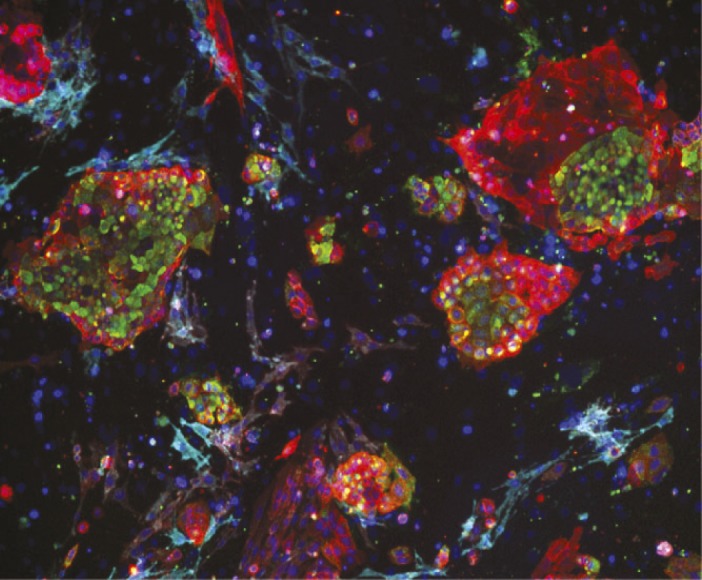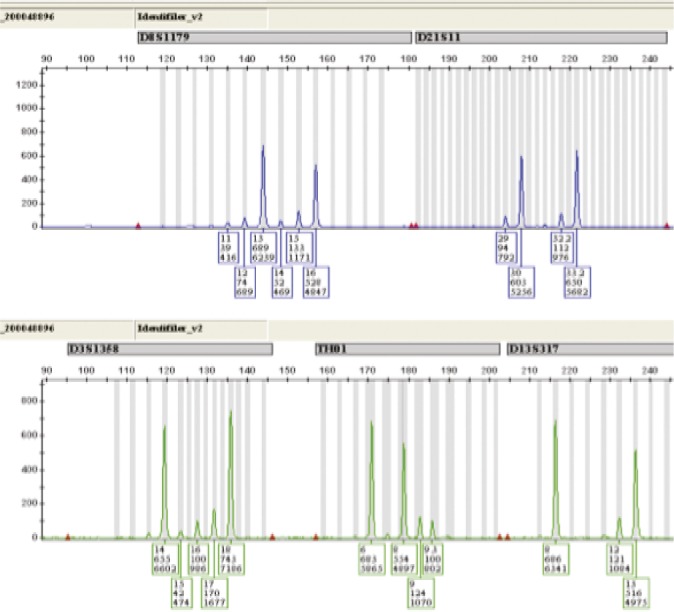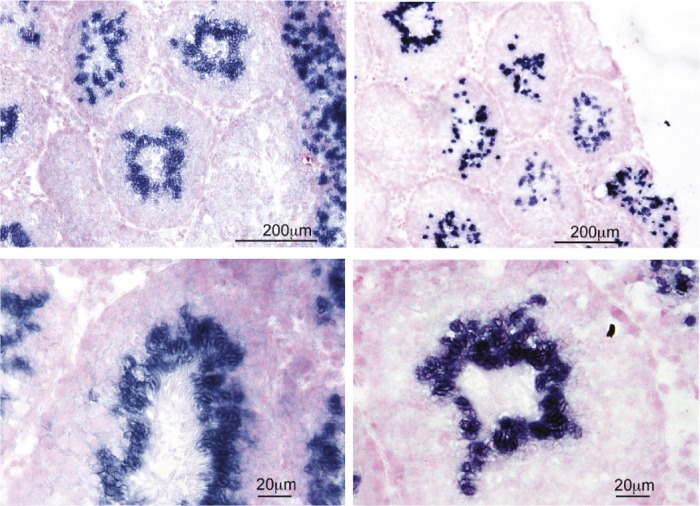Dissecting a mechanism for induced pluripotency

Reversion of TRA-1-60-expressing cells (green) back to TRA-1-60-nonexpressing (red) and their original cell fate (blue).
By forcing the expression of certain genes, researchers can prompt non-reproductive cells to transform into early embryonic cells capable of giving rise to various cell types, a phenomenon known as induced pluripotency. Koji Tanabe et al. (pp. 12172–12179) circumvented the inefficiency of this process by revealing how the forced expression of four genes—OCT3/4, SOX2, KLF4, and c-MYC (OSKM)—can reliably induce pluripotency in reprogrammed fibroblasts derived from the connective tissues of human skin. The authors reveal critical time periods during which cells can initiate reprogramming and those expressing the OSKM transgene can commit to becoming pluripotent. Within one week of forcing OSKM expression in human fibroblasts, 1 in 5 cells began to display the TRA-1-60 antigen, a marker of pluripotency. When these cells were transferred to new plates, however, only 1 in 100 matured into induced pluripotent stem cells (iPSCs), whereas the remaining cells reverted to their original state. The authors explored four factors previously reported to promote reprogramming and found that the reversion could be suppressed by the RNA-binding protein, LIN28. According to the authors, these findings suggest that the maturation of iPSCs, rather than the initiation of pluripotency, poses the greatest obstacle to the reprogramming of human fibroblasts. — A.G.
Evaluating low-template DNA profiles for forensic science

Portion of an electropherogram that shows low-template DNA profiling results from the trial of Knox and Sollecito. Image courtesy of Carla Vecchiotti (Sapienza Universita di Roma, Rome).
DNA sequencing techniques have become sensitive enough to provide a genetic profile from just a few cells’ worth of genetic material. Although low-template profiles represent a powerful evidentiary tool for law enforcement, highly visible criminal cases have collapsed partly due to media and judicial skepticism about the underlying science. Citing a number of cases in which low-template DNA profiles influenced the eventual outcome, David Balding (pp. 12241–12246) suggests that courts and commentators should focus on how this evidence is currently being analyzed and interpreted rather than the reliability of the science. Pointing to shortcomings in the statistical methods currently used to evaluate low-template DNA profiles, the author proposes a different method that not only allows for stochastic effects such as allele dropout and dropin but better interprets degraded and mixed samples that contain DNA from different contributors. Furthermore, the computer code that implements the analysis, the author reports, is an open-source code, allowing wide scrutiny. The author also illustrates the method’s performance using simulated crime scene profiles and real cases, such as the highly publicized 2009 trial in Perugia, Italy, of Amanda Knox and Raffaele Sollecito, suggesting the method’s particular advantages for forensic science. — T.J.
Localizing long-term memory in the brain
Researchers have long proposed candidate biomolecules that might represent substrates of long-term memory, which can last over a lifespan and even survive prolonged interruptions such as comas. But such molecules, typically turned over within days, must transfer information thousands of times to serve as suitable substrates for memory. Because of the challenges tied to the fidelity of such information transfer, Roger Tsien (pp. 12456–12461) proposes an alternate hypothesis: Long-term memories might be stored in the pattern of holes in a structure called the perineuronal net (PNN), a gauzy, proteoglycan-rich matrix that envelops neurons, allows synapse formation through gaps in the net and may restrict synaptic plasticity by virtue of its metabolic stability. To test the structure’s potential role in long-term memory, Tsien proposes a series of thought experiments—including practicable details—that might reveal whether the holes in the PNN are selectively altered by enzymes known to degrade the matrix. Tsien suggests that the 3D mesh of the PNN and synapses could be imaged using serial-section EM; the lifetimes of the PNN and synaptic components could be compared using pulse-chase labeling of mice and cadaver brains; a genetically encoded reporter could help link patterns of neuronal activity to PNN erosion and animal behavior; and, finally, novel methods to image nascent proteins could illuminate the biosynthesis of PNN components. According to the author, unraveling the role of the PNN in lifelong memory is evocative of the groundbreaking efforts that revealed the role of DNA in information transfer across generations. — P.N.
Three commercial sites reveal the unique challenges of underground CO2 storage
The suite of technologies known as carbon capture and storage (CCS) propose capturing anthropogenic CO2 at the point of emission and injecting it into suitable underground geological repositories. For this scheme to work, however, the CO2 must remain trapped for thousands of years or more, and some studies have argued that the increase in pore pressure caused by the injection would open fractures that compromise the integrity of the repository seal. To investigate this outstanding question, James Verdon et al. (pp. E2762–E2771) examined three commercial-scale CCS sites that inject CO2 into the subsurface at rates of 1 megaton per year or more: Sleipner Field in the Norwegian North Sea; Weyburn Field in Central Canada; and the In Salah Field in Algeria. Focusing on the threat posed by geomechanical deformation to the integrity of the repository seal, the authors detail how these three sites, each with a unique history and setting, exhibit different geomechanical responses The results highlight the need for systematic geomechanical appraisals at all CCS sites prior to injection, and the study demonstrates that future large-scale CCS operations must conduct comprehensive, multifaceted monitoring during injection to ensure the continued integrity of underground storage sites, according to the authors. — T.J.
Fat cells may directly sense temperature
To help maintain body temperature in cold environments specialized fat tissue known as brown fat converts chemical energy into heat. Brown fat senses cold indirectly via peripheral nerves, which stimulate heat production, or thermogenesis, by activating β-adrenergic receptors (β-ARs) on fat cells. Although brown fat thermogenesis is impaired in mice that lack β-ARs, Li Ye et al. (pp. 12480–12485) found that upon cold exposure these animals displayed increased expression of thermogenic genes in the subcutaneous white fat layer beneath the skin, suggesting that subcutaneous fat cells may regulate heat production through a β-AR-independent pathway. To determine whether subcutaneous fat cells sense environmental temperatures directly, the authors exposed fat cells in culture to a range of temperatures between 27 and 39 °C, and found that temperatures below 33 °C induced the expression of thermogenic genes in white and beige fat cells, but not brown fat cells. Furthermore, the induction of these genes occurred independently of β-AR and the classical intracellular communication pathway that mediates the cold-responsive thermogenesis program in brown fat. The findings suggest that temperature may directly stimulate heat production in certain fat cells, and reveal a potential target for the treatment of obesity and metabolic diseases, according to the authors. — N.Z.
Testes-expressed “taste” genes involved in male fertility in mice

Taste gene mRNAs are expressed in the germ cells of male mice.
Identified for their role in sugar and amino acid sensing in taste buds, members of the TAS1R family of taste receptors and their associated protein known as gustducin have since been found to be expressed in the intestines, brain, testes, and sperm, although their functions outside the mouth have remained unclear. Bedrich Mosinger et al. (pp. 12319–12324) found that the taste receptor TAS1R3 and GNAT3, the α-subunit of gustducin, are expressed in the testis and sperm of mice. To investigate the function of these proteins, the authors attempted to genetically delete both copies of each gene in mice, but only obtained two male double-null offspring despite many mating attempts during a 9 month period. Both males had immotile sperm, but otherwise appeared to be normal. To gain further insight into the roles of TAS1R3 and GNAT3 in male fertility, the authors developed a double-null mouse model that expressed a humanized form of the TAS1R3 receptor. Chemical inhibition of human TAS1R3 in double-null animals resulted in temporary male sterility due to malformed and non-functional sperm. The findings suggest that the “taste” genes TAS1R3 and GNAT3 are important for sperm development and maturation, according to the authors. — N.Z.


